Get free scan and check if your device is infected.
Remove it nowTo use full-featured product, you have to purchase a license for Combo Cleaner. Seven days free trial available. Combo Cleaner is owned and operated by RCS LT, the parent company of PCRisk.com.
What is FireScam?
FireScam is malware targeting Android devices. Threat actors spread the malware through a fake Telegram Premium app on a phishing site. FireScam infects devices with a dropper APK. The malware avoids detection and steals data by using popular services like Firebase. It should be eliminated from infected devices as soon as possible.
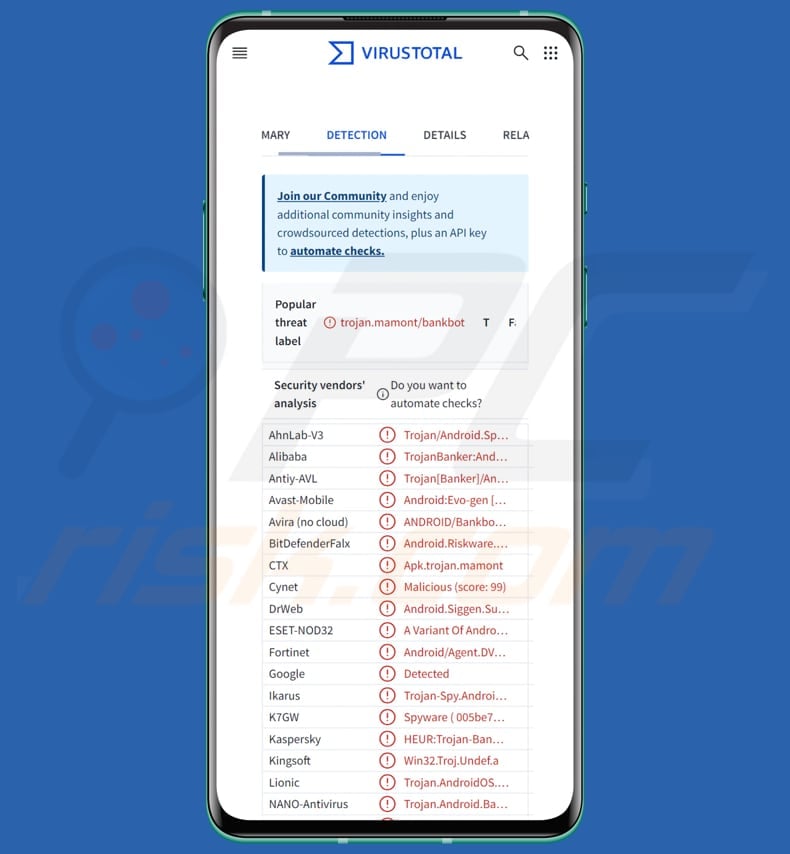
FireScam in detail
Once infiltrated, FireScam checks the infected device's apps and details, like the model and system version, to see if it is in a controlled or virtual environment. This helps it avoid detection, adjust attacks, and bypass security measures for a successful operation.
FireScam registers a service to handle Firebase push notifications. Upon receiving a message, a certain event activates the service. This service can run remote commands, deliver malicious payloads, and send sensitive data from the device to a remote server without the victim's awareness.
Also, the malware can access the Messages app and capture the contents of text messages. This function allows attackers to access and steal private message data. Moreover, FireScam detects when the device's screen is turned on or off and logs the event along with the app name. It then sends this information to a Firebase database, giving attackers a way to track device activity.
The malware also uses a service to track certain notifications on the device, like message alerts. It ignores some types of notifications, like silent ones. The apps FireScam might target include Telegram, Viber, VK, and WhatsApp. FireScam also targets data from other applications, such as the Phone app, Google Play Store, and others.
FireScam monitors all notifications that fit certain filters, allowing it to access sensitive information from any app. It asks for permission to view all notifications, letting it intercept messages, call alerts, and track activities like logins, which compromises privacy.
The malware listens for USSD responses (like from mobile services) and captures details such as account balances or transactions. With access to SMS and phone services, it can secretly track USSD actions and steal sensitive data.
Moreover, FireScam tracks data from various sources like text input, autofill data, clipboard, drag-and-drop actions, and app sharing. It harvests sensitive information, such as passwords or personal messages, and sends it to a remote server. By monitoring where the data comes from, it can target specific information for theft, acting as spyware.
The malware also checks how long the screen stays active and records user interactions. By monitoring user activity, the malware can learn about app usage and user habits, allowing it to gather sensitive information for targeted ads, fraud, or spying.
Also, FireScam monitors e-commerce activities by checking for specific events like purchases or refunds. If it detects such events, it logs them, allowing it to track user behavior in shopping apps. This can help the malware gather sensitive transaction and payment data.
It is also important to note that FireScam can download images from a specific URL. This could be used to transfer data or deliver additional malicious payloads (malware hidden within images). It may use Firebase Messaging or other channels to receive these images, allowing for further attacks.
| Name | FireScam spyware |
| Threat Type | Android malware, malicious application, unwanted application. |
| Detection Names | Avast-Mobile (Android:Evo-gen [Trj]), Combo Cleaner (Android.Riskware.Kerty.aAGC), ESET-NOD32 (A Variant Of Android/Spy.Agent.DVZ), Kaspersky (HEUR:Trojan-Banker.AndroidOS.Mamont.bb), Full List (VirusTotal) |
| Symptoms | The device is running slow, system settings are modified without user's permission, questionable applications appear, data and battery usage is increased significantly, browsers redirect to questionable websites, intrusive advertisements are delivered. |
| Distribution methods | Social engineering, deceptive applications, scam websites. |
| Damage | Stolen personal information (private messages, logins/passwords, etc.), decreased device performance, battery is drained quickly, decreased Internet speed, huge data losses, monetary losses, stolen identity. |
| Malware Removal (Windows) |
To eliminate possible malware infections, scan your computer with legitimate antivirus software. Our security researchers recommend using Combo Cleaner. Download Combo CleanerTo use full-featured product, you have to purchase a license for Combo Cleaner. 7 days free trial available. Combo Cleaner is owned and operated by RCS LT, the parent company of PCRisk.com. |
Conclusion
In conclusion, FireScam is a highly sophisticated piece of malware that leverages various tactics to infiltrate and monitor infected devices. It is a dangerous and persistent threat that compromises privacy, facilitates data theft, and opens the door for additional malicious activities.
Some examples of other Android malware are NoviSpy, PlainGnome, and BoneSpy.
How did FireScam infiltrate my device?
The malware is spread through a fake Telegram Premium APK on a phishing website hosted on GitHub.io, which pretends to be the RuStore app store. The website delivers a dropper that installs FireScam, which is disguised as the Telegram Premium app. The main malware file, Telegram Premium.apk (ru.get.app), is designed to infect devices running Android versions from 8 to 15.
The dropper installs as an app called GetAppsRu. When you open it, it shows an option to install Telegram Premium. After showing a security warning, it installs the FireScam malware (called child.apk) on the device, pretending to be the Telegram Premium app.
How to avoid installation of malware?
Download appsfrom trusted sources, such as official app stores (Google Play, Apple App Store) or reputable websites. Use reputable antivirus software to detect and block threats. Regularly update all apps and the operating system. Do not click on links or open attachments in unsolicited emails or messages, especially from unknown senders.
Avoid interacting with pop-ups, ads, links, buttons, etc., encountered on dubious websites.
Deceptive website promoting a fake Telegram Premium app (source: cyfirma.com):
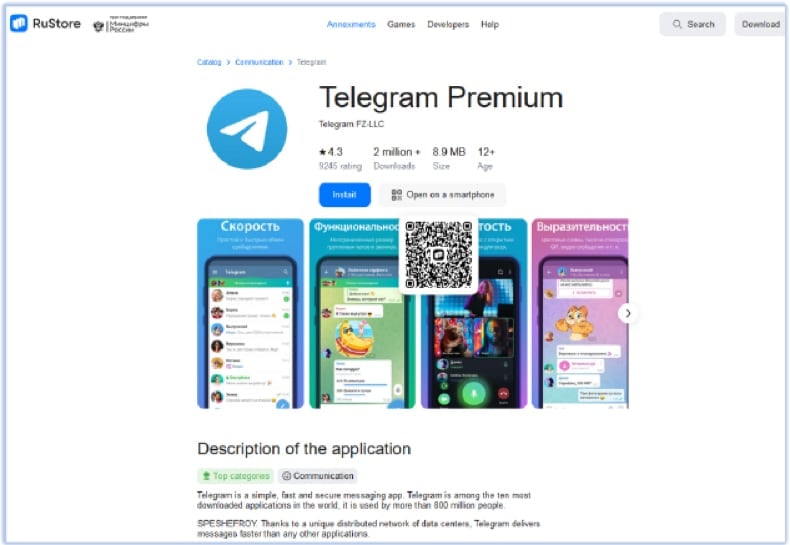
FireScam installation prompt (source: cyfirma.com):
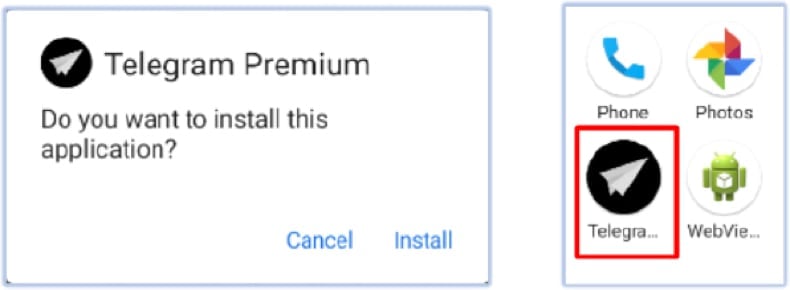
Fake app requests permissions (source: cyfirma.com):
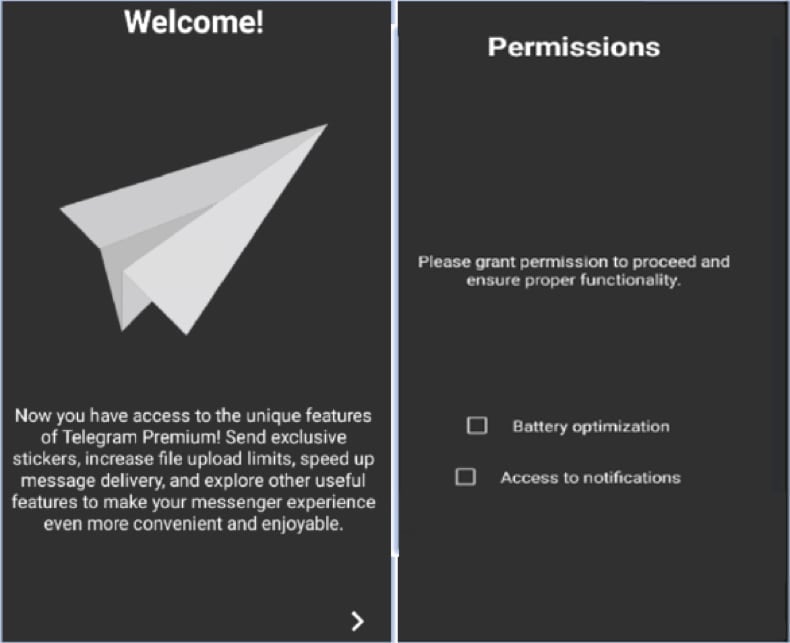
Fake Telegram login window (source: cyfirma.com):
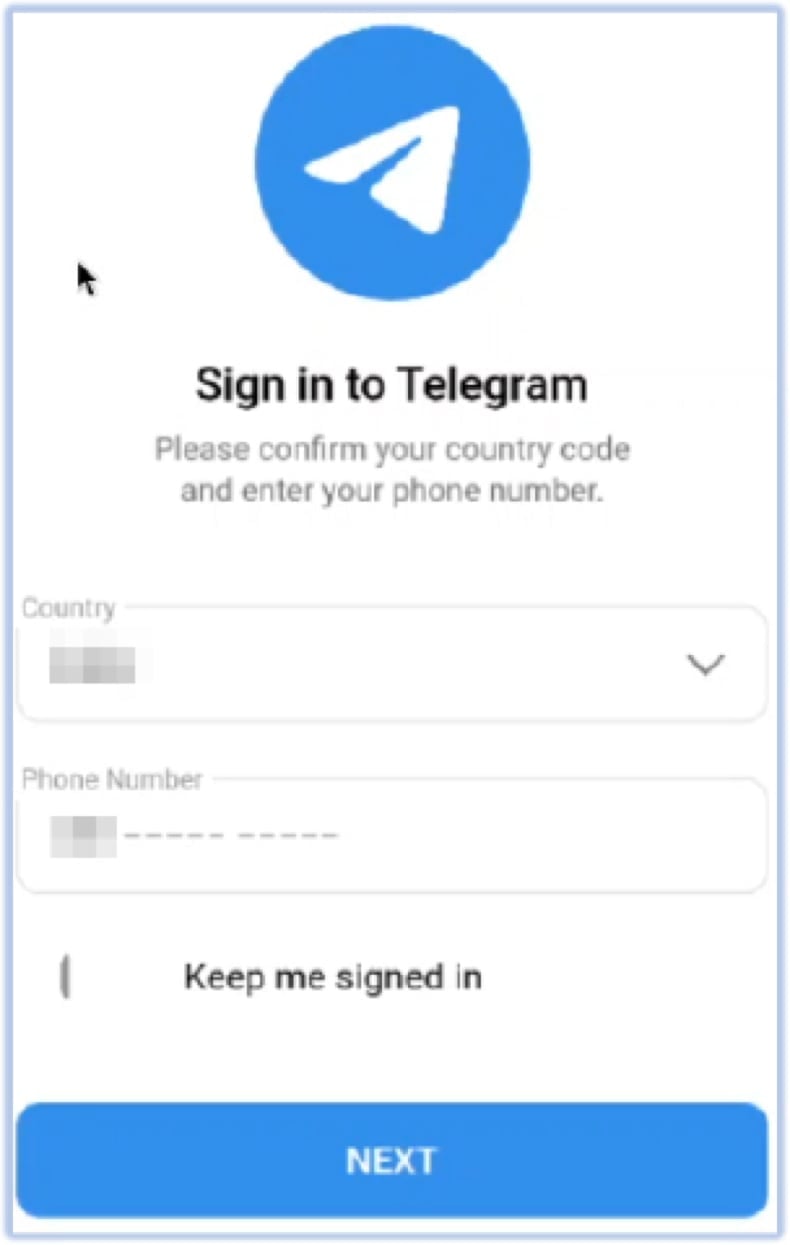
Quick menu:
- Introduction
- How to delete browsing history from the Chrome web browser?
- How to disable browser notifications in the Chrome web browser?
- How to reset the Chrome web browser?
- How to delete browsing history from the Firefox web browser?
- How to disable browser notifications in the Firefox web browser?
- How to reset the Firefox web browser?
- How to uninstall potentially unwanted and/or malicious applications?
- How to boot the Android device in "Safe Mode"?
- How to check the battery usage of various applications?
- How to check the data usage of various applications?
- How to install the latest software updates?
- How to reset the system to its default state?
- How to disable applications that have administrator privileges?
Delete browsing history from the Chrome web browser:

Tap the "Menu" button (three dots on the right-upper corner of the screen) and select "History" in the opened dropdown menu.
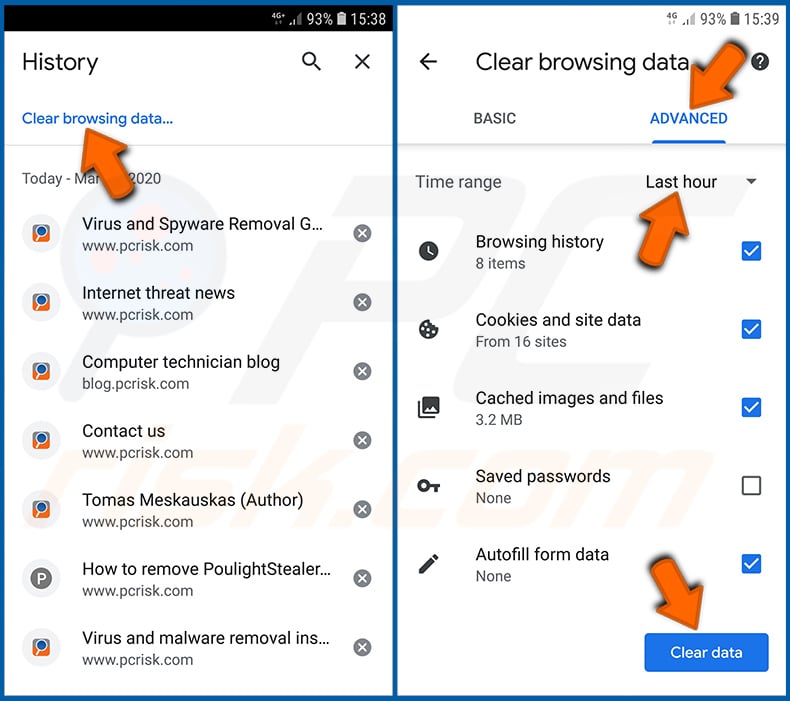
Tap "Clear browsing data", select "ADVANCED" tab, choose the time range and data types you want to delete and tap "Clear data".
Disable browser notifications in the Chrome web browser:

Tap the "Menu" button (three dots on the right-upper corner of the screen) and select "Settings" in the opened dropdown menu.

Scroll down until you see "Site settings" option and tap it. Scroll down until you see "Notifications" option and tap it.

Find the websites that deliver browser notifications, tap on them and click "Clear & reset". This will remove permissions granted for these websites to deliver notifications. However, once you visit the same site again, it may ask for a permission again. You can choose whether to give these permissions or not (if you choose to decline the website will go to "Blocked" section and will no longer ask you for the permission).
Reset the Chrome web browser:

Go to "Settings", scroll down until you see "Apps" and tap it.

Scroll down until you find "Chrome" application, select it and tap "Storage" option.

Tap "MANAGE STORAGE", then "CLEAR ALL DATA" and confirm the action by taping "OK". Note that resetting the browser will eliminate all data stored within. This means that all saved logins/passwords, browsing history, non-default settings and other data will be deleted. You will also have to re-login into all websites as well.
Delete browsing history from the Firefox web browser:

Tap the "Menu" button (three dots on the right-upper corner of the screen) and select "History" in the opened dropdown menu.

Scroll down until you see "Clear private data" and tap it. Select data types you want to remove and tap "CLEAR DATA".
Disable browser notifications in the Firefox web browser:

Visit the website that is delivering browser notifications, tap the icon displayed on the left of URL bar (the icon will not necessarily be a "Lock") and select "Edit Site Settings".

In the opened pop-up opt-in the "Notifications" option and tap "CLEAR".
Reset the Firefox web browser:

Go to "Settings", scroll down until you see "Apps" and tap it.

Scroll down until you find "Firefox" application, select it and tap "Storage" option.

Tap "CLEAR DATA" and confirm the action by taping "DELETE". Note that resetting the browser will eliminate all data stored within. This means that all saved logins/passwords, browsing history, non-default settings and other data will be deleted. You will also have to re-login into all websites as well.
Uninstall potentially unwanted and/or malicious applications:

Go to "Settings", scroll down until you see "Apps" and tap it.

Scroll down until you see a potentially unwanted and/or malicious application, select it and tap "Uninstall". If, for some reason, you are unable to remove the selected app (e.g., you are prompted with an error message), you should try using the "Safe Mode".
Boot the Android device in "Safe Mode":
The "Safe Mode" in Android operating system temporarily disables all third-party applications from running. Using this mode is a good way to diagnose and solve various issues (e.g., remove malicious applications that prevent users you from doing so when the device is running "normally").

Push the "Power" button and hold it until you see the "Power off" screen. Tap the "Power off" icon and hold it. After a few seconds the "Safe Mode" option will appear and you'll be able run it by restarting the device.
Check the battery usage of various applications:

Go to "Settings", scroll down until you see "Device maintenance" and tap it.

Tap "Battery" and check the usage of each application. Legitimate/genuine applications are designed to use as low energy as possible in order to provide the best user experience and to save power. Therefore, high battery usage may indicate that the application is malicious.
Check the data usage of various applications:

Go to "Settings", scroll down until you see "Connections" and tap it.

Scroll down until you see "Data usage" and select this option. As with battery, legitimate/genuine applications are designed to minimize data usage as much as possible. This means that huge data usage may indicate presence of malicious application. Note that some malicious applications might be designed to operate when the device is connected to wireless network only. For this reason, you should check both Mobile and Wi-Fi data usage.

If you find an application that uses a lot of data even though you never use it, then we strongly advise you to uninstall it as soon as possible.
Install the latest software updates:
Keeping the software up-to-date is a good practice when it comes to device safety. The device manufacturers are continually releasing various security patches and Android updates in order to fix errors and bugs that can be abused by cyber criminals. An outdated system is way more vulnerable, which is why you should always be sure that your device's software is up-to-date.

Go to "Settings", scroll down until you see "Software update" and tap it.

Tap "Download updates manually" and check if there are any updates available. If so, install them immediately. We also recommend to enable the "Download updates automatically" option - it will enable the system to notify you once an update is released and/or install it automatically.
Reset the system to its default state:
Performing a "Factory Reset" is a good way to remove all unwanted applications, restore system's settings to default and clean the device in general. However, you must keep in mind that all data within the device will be deleted, including photos, video/audio files, phone numbers (stored within the device, not the SIM card), SMS messages, and so forth. In other words, the device will be restored to its primal state.
You can also restore the basic system settings and/or simply network settings as well.

Go to "Settings", scroll down until you see "About phone" and tap it.

Scroll down until you see "Reset" and tap it. Now choose the action you want to perform:
"Reset settings" - restore all system settings to default;
"Reset network settings" - restore all network-related settings to default;
"Factory data reset" - reset the entire system and completely delete all stored data;
Disable applications that have administrator privileges:
If a malicious application gets administrator-level privileges it can seriously damage the system. To keep the device as safe as possible you should always check what apps have such privileges and disable the ones that shouldn't.

Go to "Settings", scroll down until you see "Lock screen and security" and tap it.

Scroll down until you see "Other security settings", tap it and then tap "Device admin apps".

Identify applications that should not have administrator privileges, tap them and then tap "DEACTIVATE".
Frequently Asked Questions (FAQ)
My device is infected with FireScam malware, should I format my storage device to get rid of it?
Formatting your storage device can remove the malware, but it is a drastic measure. Before resorting to that, run a full scan with trusted security software like Combo Cleaner to check if it can detect and remove the FireScam.
What are the biggest issues that malware can cause?
Malware can lead to data loss, theft of personal information, system crashes, slow performance, unauthorized access to sensitive files, financial losses, identity theft, and the spread of additional infections.
What is the purpose of FireScam?
FireScam is designed to steal valuable information, spy on users, and perform further malicious actions while remaining undetected on the device.
How did FireScam infiltrate my device?
FireScam likely infiltrated your device through a fake "Telegram Premium" app downloaded from a phishing website. The app acts as a dropper, installing the malware and requesting permissions to access sensitive data like messages and notifications. It then communicates with a remote server to steal information and track user activities.
Will Combo Cleaner protect me from malware?
Yes, Combo Cleaner can detect and remove nearly all known malware infections. However, advanced malware often hides deep within the system, so it is recommended to run a full system scan to ensure complete removal.
Share:

Tomas Meskauskas
Expert security researcher, professional malware analyst
I am passionate about computer security and technology. I have an experience of over 10 years working in various companies related to computer technical issue solving and Internet security. I have been working as an author and editor for pcrisk.com since 2010. Follow me on Twitter and LinkedIn to stay informed about the latest online security threats.
PCrisk security portal is brought by a company RCS LT.
Joined forces of security researchers help educate computer users about the latest online security threats. More information about the company RCS LT.
Our malware removal guides are free. However, if you want to support us you can send us a donation.
DonatePCrisk security portal is brought by a company RCS LT.
Joined forces of security researchers help educate computer users about the latest online security threats. More information about the company RCS LT.
Our malware removal guides are free. However, if you want to support us you can send us a donation.
Donate
▼ Show Discussion